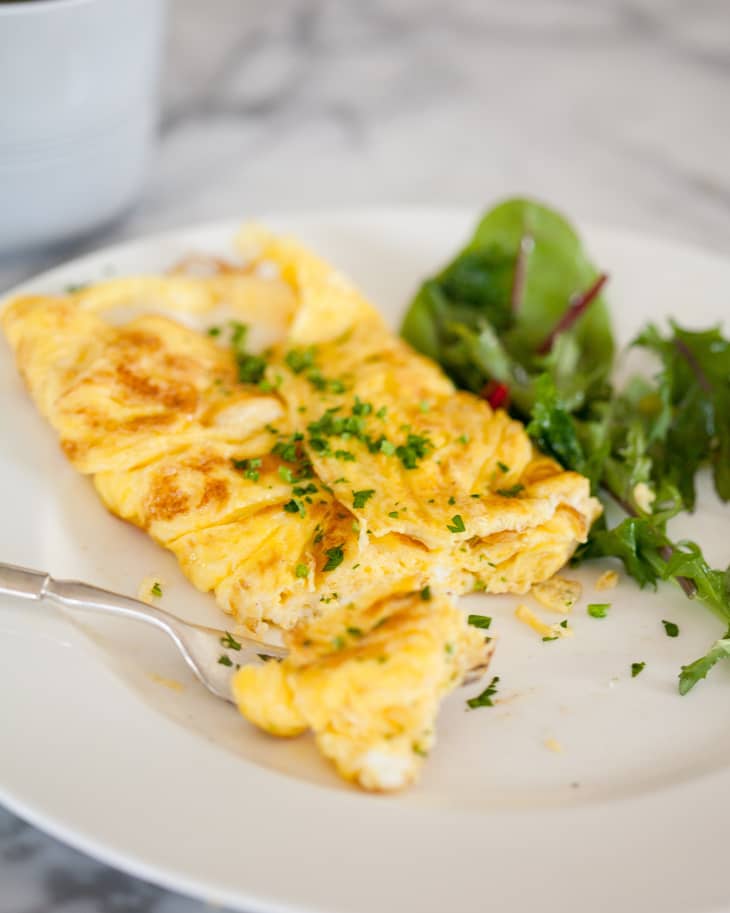How To Make a French Omelette

Makes1 omelette
A well-made omelette is a thing of magnificence. It’s soft and custard-like, golden-yellow, and best eaten while still piping hot from the skillet. An omelette makes a fantastic breakfast seasoned with just salt and pepper, but it’s also a mighty fine delivery vehicle for anything from diced ham to sautéed mushrooms, eaten any time of day.
Omelettes can also be intimidating in their simplicity. No more! Today, we’ll show you how to make a perfect omelette, from whisking the eggs to sliding the finished omelette onto your plate.
2 Essentials for a Great Omelette
There are two tricks to making a great omelette. First, use a nonstick skillet. This is one of the few times when we truly recommend a pan like this — it just makes the whole process of quickly cooking the eggs and sliding them onto the plate a million times easier. A small well-seasoned cast iron skillet will also do the job. If you don’t have either of these pieces of cookware, then use a little extra butter in your pan.
The second trick is to cook the omelet until it looks just under done. The bottom should be firm and set, but the top should still look a little wet. If you wait until the top is dry, then your omelette will be dry — and that is no one’s idea of a good breakfast. But if you’re not a fan of runny eggs, don’t worry; the eggs will finish cooking in the residual heat after you fold it.
From start to finish, an omelette should take you no more than a minute or two. It really is a quick-cooking dish (and another reason omelettes are a great breakfast or quick midweek dinner)! If you’re adding fillings to your omelette, just make sure those are cooked or re-warmed, if needed, and ready to go before you actually start making the omelette. When that omelette is done, you want to be able to add the fillings, fold the omelette over, and eat it right away.
Making a great omelette takes practice, so don’t worry if your first few attempts end up looking more like scrambled eggs. No harm done — they’re just eggs! —and you’ll get better each time you try.
Questions? Omelette tips? Favorite fillings? Let us know in the comments!
More Omelette Ideas
How To Make a French Omelette
Makes 1 omelette
Nutritional Info
Ingredients
- 2
large eggs
Salt and pepper
- 2 to 3 tablespoons
shredded cheese (optional)
- 1/4 to 1/2 cup
filling, pre-cooked if necessary (optional)
- 2 teaspoons
unsalted butter
Minced parsley, to garnish (optional)
Equipment
Mixing bowl
Whisk
8-inch nonstick skillet
Spatula
Dinner plate
Instructions
Whisk the eggs: Crack both eggs into a mixing bowl. Whisk the eggs until completely combined, and season with salt and pepper. If you're adding cheese or other fillings, make sure they are prepped and nearby.
Warm the skillet and melt the butter: Place an 8-inch skillet over medium-high heat and melt the butter. Tilt the skillet as the butter melts to evenly coat the bottom. When the butter stops sizzling, the pan is heated and ready.
Pour the eggs into the skillet: Pour the whisked eggs into the skillet. Immediately tilt the pan so the eggs coat the entire bottom. The eggs should sizzle on contact; if not, continue cooking, but remember to heat the pan a little longer next time.
Drag and push the eggs to form waves: Use a spatula to gently drag and push the cooked eggs from the edges toward the center of the pan, making space for the uncooked eggs and forming waves in the omelette. Tilt the skillet so that the uncooked eggs flow into the open spaces.
Cook the omelette for 1 to 2 minutes: The omelette will finish cooking in 1 to 2 minutes. When done, the bottom will be set and the edges will look crisp. The top of the omelette should still look fairly wet and uncooked, but there will no longer be any loose, easily flowing liquid egg — the omelette will continue cooking off the heat, so finish when you think the top still seems a bit underdone.
Top with cheese and fillings: If using, sprinkle the cheese and fillings down the center of the omelette.
Fold the omelette: Fold the bottom third of the omelette over the center, and then fold the top third down. Alternatively, fold the omelette in half.
Slide the omelette onto a plate: Gently slide the omelette onto a plate and garnish with parsley. Eat right away while still hot.
Recipe Notes
8-inch vs. 10-inch skillet: An 8-inch skillet is perfect for making a fluffy, satisfying 2-egg omelette. If your pan is bigger, your omelet will be thinner. Alternatively, add an extra egg or two and split your omelet with a friend!
